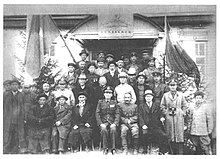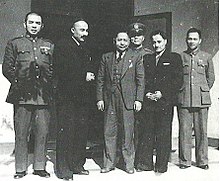Ehmetjan Qasim
Ehmetjan Qasim | |
|---|---|
ئەخمەتجان قاسىمى | |
 | |
| Minister of Foreign Affairs of the East Turkestan Republic | |
| In office November 1944 – 27 June 1946 | |
| Vice Chairman of the Coalition Government of Xinjiang Province | |
| In office 27 June 1946 – 12 August 1947 | |
| Personal details | |
| Born | 15 April 1914 Russian SFSR, Soviet Union |
| Profession | Politician |
| Ehmetjan Qasim | |
|---|---|
| Chinese name | |
Hanyu Pinyin | Āhémǎitíjiāng Hāsīmù |
| Wade–Giles | A1-he2-mai3-t'i2-chiang1 Ha1szu1mu4 |
| IPA | [áxɤ̌màɪtʰǐtɕjáŋ xásímû] |
| Transcriptions | |
|---|---|
| Latin Yëziqi | Exmetjan Qasimi |
| Yengi Yeziⱪ | Əhmətjan Ⱪasimi |
| Siril Yëziqi | Ахметжан Касими |
Ehmetjan Qasim[note 1] (Uyghur: ئەخمەتجان قاسىمى; April 15, 1914 – August 27, 1949) was a Uyghur revolutionary and statesman who held several important positions in the governments of the Second East Turkestan Republic and the Republic of China's Xinjiang Province.[1][2][3][4][5] He notably served as the vice chairman of the Coalition Government of Xinjiang Province.[6]
Qasim was born in Ghulja in 1914. He studied at the Communist University of the Toilers of the East, Moscow in 1936 and was a member of Communist Party of the Soviet Union. Qasim was described as "Stalin's man" and as a "communist-minded progressive".[7]
Life and political career
Qasim was born in Ghulja (Yining in Chinese) in 1914. He studied in the Soviet Union at the Communist University of the Toilers of the East, Moscow in 1936 and was a member of Communist Party of the Soviet Union. Qasim was described as "Stalin's man" and as a "communist-minded progressive".[7] Qasim Russified his surname to "Kasimov" and became a member of the Communist Party of the Soviet Union.



He was a member of the governing council of the East Turkestan Republic, a Soviet-backed administration founded in three northwestern districts of Xinjiang during the Ili Rebellion in November 1944.[8] Qasim himself was not involved with the planning of the rebellion.[9] The ETR was initially led by Elihan Tore, who favored forming a conservative Islamic government.[10] Tore was placed under house arrest in the Soviet Union in 1946, under the orders of Stalin. Qasim was a leader of the pro-Soviet East Turkistan Turkic People's National Liberation Committee (ETTPNLC).[10]
In June 1946, Qasim tried to reach a political agreement with the Nationalist government leader Zhang Zhizhong to form a coalition government in Dihua (present day Ürümqi).[11] The ETR was to be disbanded in name but as the Foreign Minister[12] of the East Turkestan Republic, Qasim called for unity and support for his government and rejected the coalition government.[13] He explained that the people of East Turkestan had risen in rebellion only to secure their rights under the Chinese constitution.[14] He led a delegation to the National Assembly in Nanjing to negotiate bi-lateral relations between ETR and the Republic of China.[14]
In the summer of 1949, as Chinese Nationalists were losing the

Saifuddin later secured the role of regional Chairman of Xinjiang, a job he kept from 1955 to 1978, with a brief respite during the Cultural Revolution.[16] News of plane crash and death of Qasim was not publicly announced in Xinjiang until early December, after the People's Liberation Army had secured the region. The ETR was officially dissolved on December 20, 1949.
Family
Ehmetjan Qasim was married in January 1945 to Mahinur Qasim, a native of Korgas County in Ili.[17] The couple had a son and a daughter.[17] In 1952, Mahinur Qasim became the mayor of Yining and joined the Chinese Communist Party.[17] She later served as a member of Standing Committee of the National People's Congress and a vice chair of the All-China Women's Federation.[18] She has been a prominent advocate of women and children's rights.[19] Her memoir of her husband, Remembering Ehmetijan, was published in China in 2011.[17]
Legacy
In the People's Republic of China, Ehmetjan Qasim is remembered as a fighter in the struggle against the Nationalist government.[20] Among the Uyghurs and other Turkic inhabitants of East Turkistan he is remembered as a national hero and fighter who died defending the independence of East Turkistan. His remains were returned to China in April 1950 and later reburied in a memorial cemetery in Yining.[20] The cemetery has a stele with calligraphy by Mao Zedong, praising Qasim and the others who died with him for their contributions to the Chinese Civil War and mourning their death en route to the Inaugural Chinese People's Political Consultative Conference in Beijing.[20]
Notes
- ^ also transliterated as Ehmetjan Qasimi, Exmetjan Qasimi, Ahmetjan Khasim, Ahmet Jan Kasimi, Aḥmadjān Qāsim or Ahmetcan Kasim
References
- ^ ئەشۇ يىللاردا ( مەرھۇم ئەخمەتجان قاسىمى ھەققىدە كۆرگەن – بىلگەن ۋە ئاڭلىغانلىرىمدىن ئەسلىمە) (in Uyghur). ئەرشىدىن تاتلىق. 25 September 2017.
- ISBN 978-962-996-500-6.
- ISBN 978-986-5870-51-5,第192頁
- ISBN 978-962-996-500-6,第158頁
- ^ 杜榮坤、紀大椿、任一飛、劉文遠,新疆三區革命史鑑,中國社會科學出版社,第161頁
- ^ ئەشۇ يىللاردا ( مەرھۇم ئەخمەتجان قاسىمى ھەققىدە كۆرگەن – بىلگەن ۋە ئاڭلىغانلىرىمدىن ئەسلىمە) (in Uyghur). ئەرشىدىن تاتلىق. 25 September 2017.
- ^ a b Forbes 1986, p. 174
- ^ Benson 1990:138
- ^ Benson 1990:140
- ^ Archive-It Last Accessed 2010-11-14
- ^ Benson 1990:63, 70
- ^ Benson, Linda (1990). The Illi Rebellion. M.E. Sharpe. p. 265.
- ^ Benson 1990:84, 101
- ^ a b Benson 1990:86
- ^ Donald H. McMillen, Chinese Communist Power and Policy in Xinjiang, 1949–1977 (Boulder, Colorado: Westview Press, 1979), p. 30.
- ^ Dillon, Michael (2004). Xinjiang: China's Muslim far northwest. Routledge. p. 79.
- ^ a b c d (Chinese) 回忆阿合买提江(上下)
- ^ (Chinese) 第七届全国妇联领导机构主要成员
- ^ (Chinese) 自治区领导会见玛依努尔·哈斯木祝贺她荣获中国内藤国际育儿奖 Archived 2016-03-03 at the Wayback Machine 2002-12-18
- ^ a b c (Chinese) "三区革命烈士陵园(三区革命历史纪念馆):伊宁市" 人民网 Archived April 2, 2015, at the Wayback Machine 2008-10-18
Bibliography
- Abdurakhman Abay, Ahmetjan Qasimi Haqqida Hikayilar, Urumqi: Xinjiang Peoples Publishing (1984)
- Benson, Linda (1990). The Ili Rebellion: the Moslem challenge to Chinese authority in Xinjiang, 1944-1949. M.E. Sharpe. ISBN 0-87332-509-5.
- Forbes, Andrew D. W. (1986). Warlords and Muslims in Chinese Central Asia: A Political History of Republican Sinkiang 1911-1949 (illustrated ed.). CUP Archive. ISBN 0521255147. Retrieved 10 March 2014.
- Zordun Sabir, Anayurt, Almaty: Nash Mir (2006)
